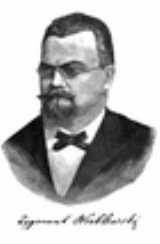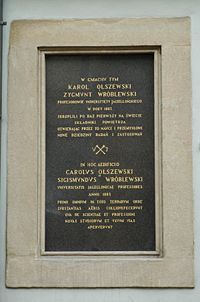
Zygmunt Florenty Wróblewski
Encyclopedia
Zygmunt Florenty Wróblewski (28 October 1845 – 16 April 1888) was a Polish
physicist
and chemist
.
, now in Belarus
). He studied at Kiev University
. After a six-year exile for participating in the January 1863 Uprising
against Imperial Russia, he studied in Berlin and Heidelberg
. He defended his doctoral dissertation at Munich University in 1876 and became an assistant professor at Strassburg University. In 1880 he became a member of the Polish Academy of Learning
.
Wróblewski was introduced to gas condensation
in Paris by Professor Caillet at the École Normale Supérieure
. When Wróblewski was offered a chair in physics at Jagiellonian University
, he accepted. At Kraków
he began studying gases and soon established a collaboration with Karol Olszewski
.
While studying carbonic acid
, Wróblewski discovered the CO2 hydrate
. He reported this finding in 1882.
On 29 March 1883 Wróblewski and Olszewski used a new method of condensing oxygen
, and on 13 April the same year—nitrogen
.
In 1888, while studying the physical properties of hydrogen
, Wróblewski upset a kerosene lamp
and was severely burned. He died soon after at a Kraków
hospital.
Karol Olszewski continued the experiments, using an improved Picket cascade apparatus, and carbon dioxide
, boiling ethylene
in vacuum
, and boiling nitrogen and boiling air as cooling agents.

Poland
Poland , officially the Republic of Poland , is a country in Central Europe bordered by Germany to the west; the Czech Republic and Slovakia to the south; Ukraine, Belarus and Lithuania to the east; and the Baltic Sea and Kaliningrad Oblast, a Russian exclave, to the north...
physicist
Physicist
A physicist is a scientist who studies or practices physics. Physicists study a wide range of physical phenomena in many branches of physics spanning all length scales: from sub-atomic particles of which all ordinary matter is made to the behavior of the material Universe as a whole...
and chemist
Chemist
A chemist is a scientist trained in the study of chemistry. Chemists study the composition of matter and its properties such as density and acidity. Chemists carefully describe the properties they study in terms of quantities, with detail on the level of molecules and their component atoms...
.
Life
Wróblewski was born in Grodno (Russian EmpireRussian Empire
The Russian Empire was a state that existed from 1721 until the Russian Revolution of 1917. It was the successor to the Tsardom of Russia and the predecessor of the Soviet Union...
, now in Belarus
Belarus
Belarus , officially the Republic of Belarus, is a landlocked country in Eastern Europe, bordered clockwise by Russia to the northeast, Ukraine to the south, Poland to the west, and Lithuania and Latvia to the northwest. Its capital is Minsk; other major cities include Brest, Grodno , Gomel ,...
). He studied at Kiev University
Kiev University
Taras Shevchenko University or officially the Taras Shevchenko National University of Kyiv , colloquially known in Ukrainian as KNU is located in Kiev, the capital of Ukraine. It is the third oldest university in Ukraine after the University of Lviv and Kharkiv University. Currently, its structure...
. After a six-year exile for participating in the January 1863 Uprising
January Uprising
The January Uprising was an uprising in the former Polish-Lithuanian Commonwealth against the Russian Empire...
against Imperial Russia, he studied in Berlin and Heidelberg
Heidelberg
-Early history:Between 600,000 and 200,000 years ago, "Heidelberg Man" died at nearby Mauer. His jaw bone was discovered in 1907; with scientific dating, his remains were determined to be the earliest evidence of human life in Europe. In the 5th century BC, a Celtic fortress of refuge and place of...
. He defended his doctoral dissertation at Munich University in 1876 and became an assistant professor at Strassburg University. In 1880 he became a member of the Polish Academy of Learning
Polish Academy of Learning
The Polish Academy of Arts and Sciences or Polish Academy of Learning , headquartered in Kraków, is one of two institutions in contemporary Poland having the nature of an academy of sciences....
.
Wróblewski was introduced to gas condensation
Condensation
Condensation is the change of the physical state of matter from gaseous phase into liquid phase, and is the reverse of vaporization. When the transition happens from the gaseous phase into the solid phase directly, the change is called deposition....
in Paris by Professor Caillet at the École Normale Supérieure
École Normale Supérieure
The École normale supérieure is one of the most prestigious French grandes écoles...
. When Wróblewski was offered a chair in physics at Jagiellonian University
Jagiellonian University
The Jagiellonian University was established in 1364 by Casimir III the Great in Kazimierz . It is the oldest university in Poland, the second oldest university in Central Europe and one of the oldest universities in the world....
, he accepted. At Kraków
Kraków
Kraków also Krakow, or Cracow , is the second largest and one of the oldest cities in Poland. Situated on the Vistula River in the Lesser Poland region, the city dates back to the 7th century. Kraków has traditionally been one of the leading centres of Polish academic, cultural, and artistic life...
he began studying gases and soon established a collaboration with Karol Olszewski
Karol Olszewski
Karol Stanisław Olszewski was a Polish chemist, mathematician and physicist.-Life:Olszewski was a graduate of Kazimierz Brodziński High School in Tarnów . He studied at Kraków's Jagiellonian University in the departments of mathematics and physics, and chemistry and biology...
.
While studying carbonic acid
Carbonic acid
Carbonic acid is the inorganic compound with the formula H2CO3 . It is also a name sometimes given to solutions of carbon dioxide in water, because such solutions contain small amounts of H2CO3. Carbonic acid forms two kinds of salts, the carbonates and the bicarbonates...
, Wróblewski discovered the CO2 hydrate
Carbon dioxide clathrate
Carbon dioxide hydrate is a Type I gas clathrate . However, there has been some experimental evidence for the development of a metastable Type II phase at temperature near the ice melting point ....
. He reported this finding in 1882.
On 29 March 1883 Wróblewski and Olszewski used a new method of condensing oxygen
Oxygen
Oxygen is the element with atomic number 8 and represented by the symbol O. Its name derives from the Greek roots ὀξύς and -γενής , because at the time of naming, it was mistakenly thought that all acids required oxygen in their composition...
, and on 13 April the same year—nitrogen
Nitrogen
Nitrogen is a chemical element that has the symbol N, atomic number of 7 and atomic mass 14.00674 u. Elemental nitrogen is a colorless, odorless, tasteless, and mostly inert diatomic gas at standard conditions, constituting 78.08% by volume of Earth's atmosphere...
.
In 1888, while studying the physical properties of hydrogen
Hydrogen
Hydrogen is the chemical element with atomic number 1. It is represented by the symbol H. With an average atomic weight of , hydrogen is the lightest and most abundant chemical element, constituting roughly 75% of the Universe's chemical elemental mass. Stars in the main sequence are mainly...
, Wróblewski upset a kerosene lamp
Kerosene lamp
The kerosene lamp is a type of lighting device that uses kerosene as a fuel. This article refers to kerosene lamps that have a wick and a tall glass chimney. Kerosene lanterns that have a wick and a glass globe are related to kerosene lamps and are included here as well...
and was severely burned. He died soon after at a Kraków
Kraków
Kraków also Krakow, or Cracow , is the second largest and one of the oldest cities in Poland. Situated on the Vistula River in the Lesser Poland region, the city dates back to the 7th century. Kraków has traditionally been one of the leading centres of Polish academic, cultural, and artistic life...
hospital.
Karol Olszewski continued the experiments, using an improved Picket cascade apparatus, and carbon dioxide
Carbon dioxide
Carbon dioxide is a naturally occurring chemical compound composed of two oxygen atoms covalently bonded to a single carbon atom...
, boiling ethylene
Ethylene
Ethylene is a gaseous organic compound with the formula . It is the simplest alkene . Because it contains a carbon-carbon double bond, ethylene is classified as an unsaturated hydrocarbon. Ethylene is widely used in industry and is also a plant hormone...
in vacuum
Vacuum
In everyday usage, vacuum is a volume of space that is essentially empty of matter, such that its gaseous pressure is much less than atmospheric pressure. The word comes from the Latin term for "empty". A perfect vacuum would be one with no particles in it at all, which is impossible to achieve in...
, and boiling nitrogen and boiling air as cooling agents.

Books
- Ueber die Diffusion der Gase durch absorbirende Substanzen (On the Diffusion of Gases through Absorbing Substances, 1874)
See also
- Timeline of low-temperature technologyTimeline of low-temperature technologyThe following is a timeline of low-temperature technology and cryogenic technology .-16th century BCE – 17th century CE :...
- Timeline of hydrogen technologiesTimeline of hydrogen technologiesTimeline of hydrogen technologies — A timeline of the history of hydrogen technology.-1600s:* 1625 - First description of hydrogen by Johann Baptista van Helmont...
- List of Poles

